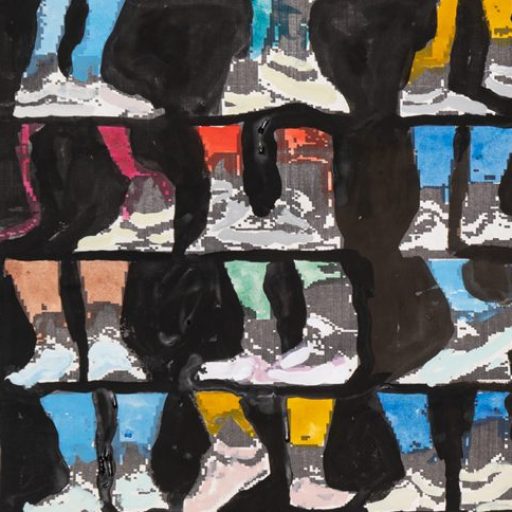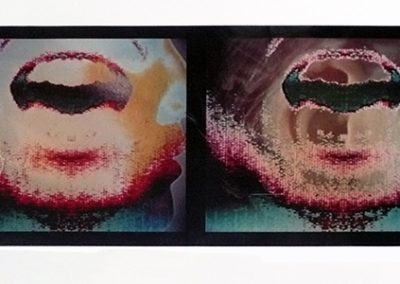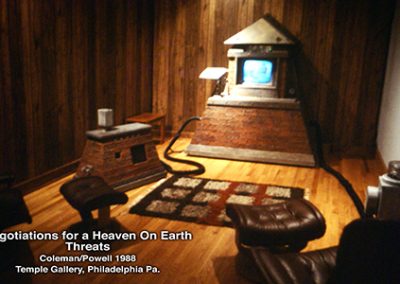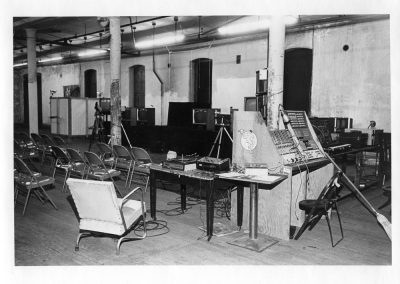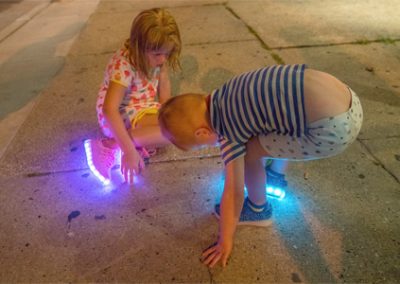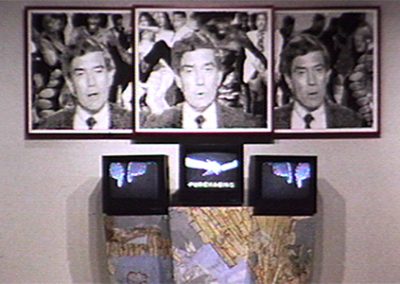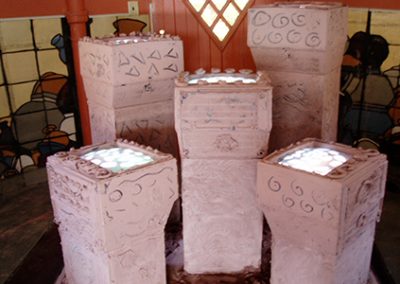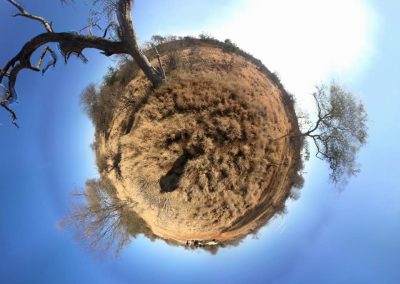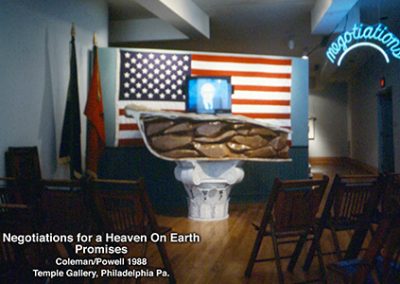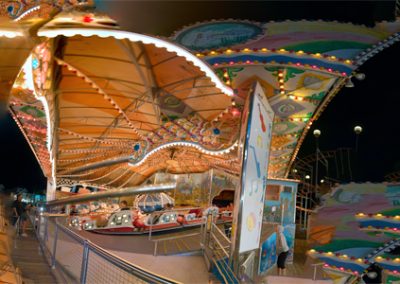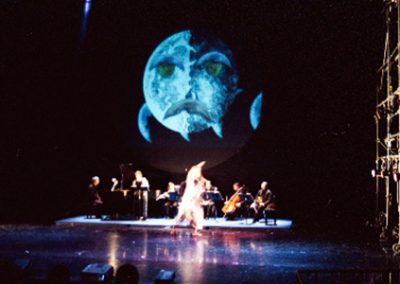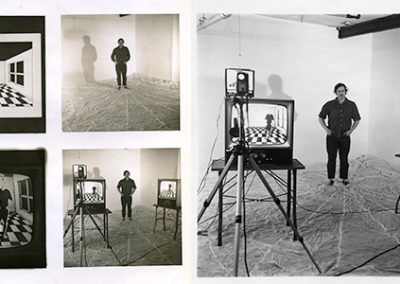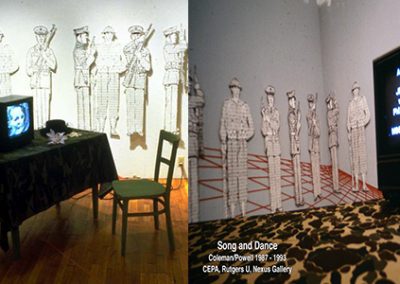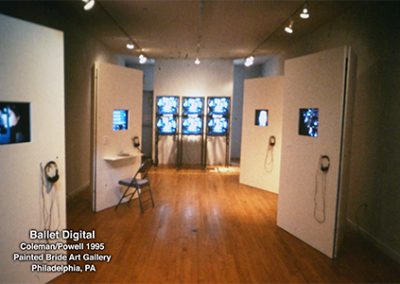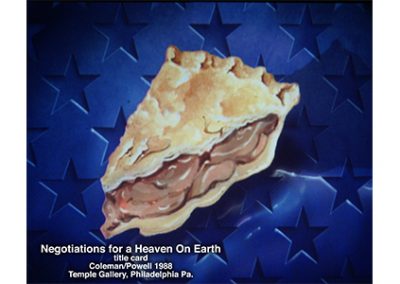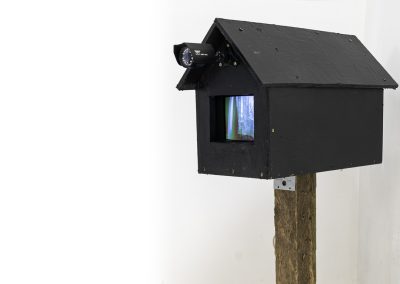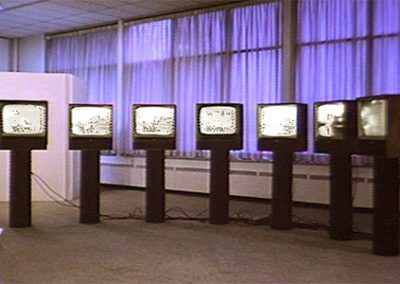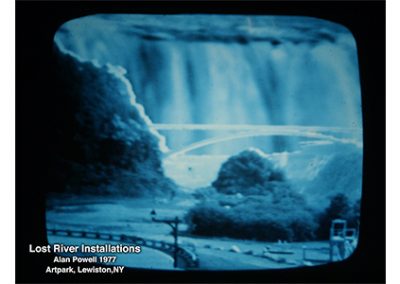Alan Powell 2023
Alan Powell is an electronic media artist whose fifty-year career has steadily pushed the boundaries of expressing information through visual art. From 1978 to the 1990s, he and partner Connie Coleman worked almost exclusively with video and electronic imaging. With moments in many genres, spanning a multitude mediums, from sculpture and painting to experimental videography, multichannel installations and audio compositions, Alan’s work ultimately coheres as an investigation into man’s relationship to his natural and political environments.
His father, an officer overseeing the governing of post-war Japan and later civil rights activist spearheading reform for many institutions in Philadelphia, instilled in Alan a sense of humility and putting others above yourself. It had guided his own life, and even becoming an artist (for whom ego is the most accessible tool) did not stop it from guiding Alan’s as well.
Brought up in the Philadelphia suburbs, Alan spent his childhood summers on a tree farm in South Bristol, New York. Those years in nature, learning wilderness survival and immersed in the heritage of the Indians indigenous to that land shaped Alan’s earliest passion. In youth he thought he would become a Forest Ranger. When he was fifteen, a teacher recognized his ability and made him aware of it; telling him he could go into art as a profession. That’s how it starts. From there, Alan’s artistry runs out seemingly pell-mell, in every direction.
He enrolled at the Rhode Island School of Design with a traditional artist background: a painter and sculptor. It was the 1970s, anti-war sentiment reaching a fever pitch, and RISD had turned over their facilities to supply graphics for the movement. The politically charged campus steered Alan towards new ways of thinking about and creating art. Wanting a more direct way of looking at the world, connecting visual process and politics, Alan was introduced to videography and photography—what would become the major and minor of his Fine Arts degree, respectively. He was influenced by the ideas of collage and montage, marrying two realities and exploring art not as an object, but information experienced over time. Among his early videotapes “Toys,” (1972), blended innocent visuals with newscasts of the world preparing for war. The summer of 1971 was partly spent New York City involved work with Rudi Stearn at Global Village. His friend Tim Young had become an editor on a project about the a IRA during The Troubles. At Nineteen, Alan had his first show at The Kitchen in Soho.
After college Alan joined a co-op in Providence. Livin’ la vida La bohéme; finding enough different ways to put a life together making art. During this time Alan was part of the development of Electron Movers, a video artist collective exploring electronic tools’ capacity for communication and art. His work with them encompassed creating choreography that existed in two-dimension and moved on multiple monitors, forming a different channel by having them all running at the same time. During a artist residency at Artpark, his video installation “Lost River” (1977) reconstructed Niagara Falls and put a live camera on the ravine. In another work at Artpark in collaboration with Robert Jungels he mounted and buried video cameras in various vantage points around a forest in an effort to mimic how a spider or a bird in this place was seeing its world. It was a full circle moment in the Powell lineage: a great Grandfather Fredrick Meyer, a Baptist minister started a movement that it was your religious duty to care for the earth. His son Walter Meyer had gone on to become the Dean of the School of Forestry at Yale University while Alan’s grandfather took it upon himself to plant 9000 trees on a barren hillside in upstate New York. Alan began finding way pathways for the natural world that had transfigured his youth to serve as a subject and background for his art.
The Powell-Coleman Years stem back to the co-op both called home base in 1978. At that time: Connie was a craftsperson -in- residence for the state of Rhode Island. Connie, an artist-in-residence working in RI state prisons and community organizations. Their meeting—some predestined bump in front of the refrigerator light—began a collaboration that would span thirty years. Through their collaboration they proved the video camera’s utility as a tool—malleable like clay, portable like a sketchbook. Together Coleman and Powell extended their practice in imaging to sculptural installation, digital photography and traditional printmaking.
They have exhibited across the United States and internationally, at The Kitchen, Hallswalls, CEPA, Squeaky Wheel, The Alternative Museum, and The Museum of the Moving Image in New York; the Philadelphia Museum of Art and the Institute of Contemporary Art in Philadelphia; The Long Beach Museum in California and the Musee d’Arte Moderne in Paris. Their videotapes have been broadcast on PBS and Swiss, Danish and Japanese television, been archived at Cornell University Library, and five pieces remain in distribution by Electronic Arts Intermix in NYC. Coleman passed away in August of 2011.
Coleman’s death sparked both a personal and professional shift for Alan. His “ever since” has been a busy time—reengaging with art associates and taking on new residencies. From 2011 to 2014, Alan was at the helm of Band of Artists, a movement for people with disabilities in the arts that translated their unique movement systems into visual language for performance art. More recently, his involvement in Studio 190, namely his contributions to their magazine, launched the work of people with disabilities. His mission was to guide away from institution and instead bring focus to the individual artists and integrate the work of Studio 190 with the arts community..
Closing down his studio in Bucks County enabled new studios in and his relocation to the Catskill Mountains. He was an artist-in-resident at the Catskill Center and joined the Ad Hoc Arts Group and the Painter’s Gallery to create a video and photographic portrait of Main Street in Fleischmanns, NY. The result was 360 degree photographs, drone footage and interviews videos of everyone living along the street; an all-inclusive answer to what life in this town was like.
Since 2003, Alan has been a professor in the Communications Program at Arcadia University. And in January of 2017, he took over their lobby. The enormity of his art installation, “Trump Dump,” (assisted by Juliana Fernandez and students of Arcadia) reverberated through campus and received national media coverage. Inspired by the pseudo-reality and oncoming dystopia dredged up from the bottom of the 2016 election, this elaborate, layered depiction of what Trump was about incensed enough to set off a six-month carousel about free speech, censorship, the right chest to pin blame on. It ended back in the lobby, where Trump Dump still stood tall. In 2021, a TermiteTV show that would go on to the Buffalo International Film Festival, “COVID Dreams” initially sought something similar to the Dump, but Alan instead contributed an abstract work that dealt with the fear of the mutating virus.
A professor emeritus at Arcadia, Alan has also taught at the Rhode Island School of Design, Bucks County Community College and Temple University. He is currently a board member at TermiteTV, a Philadelphia based collective and Signal Culture Loveland, Colorado. In quasi-retirement, Alan continues to create. He likens his current state to being a kid at art school again. Oils and acrylics, point-and-shoots and underwater cameras—everything is back on the table.
One of his works painted in a high school art class, later given to a local film crew to be used as a prop and no worries if it gets damaged, is akin to an early Van Gogh. Alan possesses that pedigree of muscle memory, but does not rely on it. His body of work has a grand design—his portfolio is not just a stack of pages that flip front to back, then backwards to front. It’s a complex network, a nervous system of creation. He describes his pursuit as trying to create a bridge between all kinds of medium; finding a bisection for his art and his politics; moving away from static pieces to grapple with time, space, perception.
Alan ordains the person standing in front of an installation as a part of the piece, extending an invitation to jump in and be part of it. His involvement in the medium spans the development of community video and democratizes the process still: by giving a voice to “everyone,” seeing anyone could be worthy of being the subject. Alan recognized this in himself and his work as far back as when he was an undergrad at RISD. When form, line, and color was being taught, he cared about what the story was, what it wanted to tell you. What Alan heard: nature changing over time, and soundbites of human life and everyday experiences.
Alan lives and works in the Catskill Mountains in New York.
